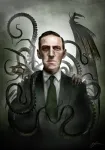Blind Read Through: H.P. Lovecraft/August Derleth; The Peabody Heritage
“For at the base of the wall, behind the baseboard, there lay, among long yellowed papers half gnawed away by mice, yet still bearing on their surfaces the unmistakably cabalistic designs of some bygone day, among wicked implements of death and destruction – short, dagger-like knives rusted by what must surely have been blood – the small skulls and bones of at least three children!“
Welcome back to another Blind Read! This week we’re unraveling Derleth’s complex love of Lovecraft while trying to understand his religious overtones thrust upon the conversely amoral Lovecraft Universe.
The first note I feel I have to hit is the overarching hope in Derleth’s horror. This is now the third story I’ve read by him and all the while there has been a niggling itch that I just couldn’t reach. These types of stories could have been written by Lovecraft, but there is something so utterly different about them and until now I just couldn’t put my finger on it. The language is slightly different, but for a reader who is only looking for story and isn’t going to dig any deeper, I’m not sure if they would notice a difference. The stories themselves are absolutely horror with fantastic elements, and similar terrifying hopeless situations the protagonists find themselves in. So what is it?
There is a subtle nearly imperceptible change. Lovecraft was depressed and that comes off in his writing style. The characters are dreary, people stuck in cycles of destitution and despair. Nearly every story has an overwhelming feeling of hopelessness.
In Derleth’s stories (thus far at least) the protagonists not only survive, but they aren’t thrust into a horrid spiral of depression and fear. It’s much more light hearted as if they’re stories told by a college buddy over drinks about an escapade, rather than a drunk recounting the horrors that led him to the bottom of the bottle to a bartender in some run down dive.
That’s an extreme statement but the sentiment is real. Lovecraft is serious, his tales have bite and nuance, whereas Derleth’s stories seem to be written more for fun.
That being said, let’s check out what fun can be had in The Peabody Heritage!
It starts out with an immediate reference to the old Lovecraft tales, “I never knew my great-grandfather Asaph Peabody…” If you’ll remember from Lovecraft’s story “In the Vault” there’s a character named Asaph (known for his angry, bucolic disposition) who’s buried in a tomb. There are things that happen in that story which echo this one, and unfortunately I knew within that first sentence what was basically going to happen at the end of this one…but more on that later.
The first chapter is about the protagonist slowly moving back into his ancestral home. It’s a fascinating description which recalls the Winchester Mystery House in San Jose, CA: “The dwelling itself was the product of many generations. It had been built originally in 1787, at first as a simple colonial house, with severe lines, an unfinished second storey, and four impressive pillars at the front. But, in time, this had become the basic part of the house, the heart, as it were. Subsequent generations had altered and added to it-at first by the addition of a floating stairway and a second storey; then by various ells and wings…”
This is a wonderful way to introduce the detective story the tale becomes as the narrator works to renovate this house so that he can live in it. He even finds the family tomb and enters it, curious about his lineage. He finds various cubbies and caskets in the tomb with the names of his family etched upon them, but then he finds Asaph’s disturbed tomb:
“Moreover, it seemed as if someone had lifted or attempted to lift the cover, for one of the hinges was broken, and the other loosened.”
Curious as to what happened he lifted the cover and, “I saw that through some hideous error, he (Asaph) had been buried face downward – I did not want to think, even at so long a time after his death, that the old man might have been buried in a cataleptic state and so suffered a painful death in that cramped, airless space.“
It’s a strange thought with the evidence of the tampered sarcophagus lid to go immediately to the idea he may be buried alive, but seemingly because of this sentiment he flips the skeleton over before putting the lid back on the coffin. Derleth handles this with deft skill because altering the remains is obviously thematically dangerous, but the way it’s written feels almost as if it’s done with a religious reverence instead of a horrible precognition.
The next chapter begins with our narrator dreaming, a theme which continues along though the entire story that connects to a major Lovecraftian concept – dreaming. The question immediately is, what does dreaming mean to Derleth? As we’ve talked about in previous Blind Reads, Lovecraft seems to consider dreaming as travelling or dimension hopping. So many of his stories held the precedent that the “dreamers” like Randolph Carter were actually time travelers who went through gates of consciousness and dimension to instantly find different areas of time and space. Derleth, starts down that road, but then seems to take a different approach here.
After finding what they consider a “priests hole” (a place to hide runaway slaves) in one of the strange void spaces in the house, the narrator, “Though ordinarily not at all given to dreams, I was literally beset by the most grotesque phantasms of sleep, in which I played a passive role and was subjected to all manner of distortions of time and space, sensory illusions, and several frightening glimpses of a shadowy figure in a conical black hat with an equally shadowy creature by his side.“
So initially this seems to indicate that because of the “distortions of time and space” that we might be getting some of that dimensional hopping, but as we get deeper into the tale we find that there is a distinct difference between dreaming and possession.
The protagonist goes into “…a space unaccounted for along the north wall upstairs, in the oldest part of the house” and found “The door to it (was) hidden in the finely-wrought carvings which decorated that entire wall,” and that “…the door which had no knob and worked only by pressure upon one of the carvings.”
I mean who doesn’t want a secret office which has a secret door with a pressure plate lock carved into a cedar relief on a wall? It’s still a dream of mine!
They go into this room and found, “...it’s angles seemed to be awry,” and there “…were curious drawings on the floor.” and all manner of strange texts (including such gems as the Malleus Maleficarum) and news stories of missing children.
Having read through Lovecraft we know instantly that this is a witches room. The odd angles, much like in “Dreams of the Witch House” and other stories, are there because they present a bend in the fabric of reality and make witchcraft easier to practice; spells more potent. The fact that there are stories of missing children lend a malevolence to the room.
Intrigued our narrator continues doing work on the house and begins having more and more prevalent dreams of this Black Man (as in color not race) and his nefarious familiar. The narrator heads to town and finds that the townsfolk are despairing of him, though he tries to be friendly. When he inquires as to their demeanor, he’s told that his family name, Peabody, has a terrible history. His ancestors were thought to have stolen children whom they killed to be used in some kind of witchcraft.
Discouraged, he goes home but finally gets a construction crew to go through that secret wall and renovate the hidden office. Through the construction he dreams of Walpurgis night (which, if you remember from Lovecraft, that’s a night of witchcraft) where he walks through the woods to a Black Mass out in the woods. There’s a group of witches along with his Black Man and large black cat which stands beside him. When the narrator wakens, he finds that his feet and legs are dirty.
Seemingly ignoring this outlandish event, he finds that the crew renovating have fled the house in disgust. When he goes to investigate, he come across the quote at the beginning of this essay. Panicked, he takes the children’s remains and puts them into one of his ancestors coffins. Then to make matters worse, three more children go missing.
And still he dreams. His somnambulant excursions take him back to the Black Mass again and again, and there’s some strange Christian iconography there which was always absent in Lovecraft. We hear of the devils, Balor, Beelzebub, and Sathanus. While Lovecraft went a long way to divest himself from any kind of religious deities, Derleth is leaning into them, seemingly in an effort to add horror from these Christian call backs.
We also find that these Devils are trying to bring him into the fold of their coven and that these nightly excursions are actually happening, they aren’t actual dreams. This is a theme that we’ve seen in “The Case of Charles Dexter Ward” as well, where an ancestor of a character begins to take over the living relative because they accidentally took part in reviving the ancestor. We get confirmation of this when the narrator goes to the crypt and checks on Asaph’s grave and finds that the bones have begun to grow skin, and there are three bodies of children in the coffin with Asaph’s remains!
And here is that call back from earlier. Remember when I said we’d see how the story ended? in the tale “In the Vault” Asaph was a corpse who came alive and tried to kill one the characters of that tale. Asaph as corpse bit into his leg and tried to make him fall to his death on the stone ground. In this story, the disturbed body is what actually causes the Demon Balor to come back, as turning him over reinstated the machinations of the Devils.
The fact is that the narrator wasn’t dreaming, but because he turned the body over, he allowed Asaph to come into his body and use it to go to the Black Mass. It was possession, not dreaming.
So in the end we have the narrator fighting these forces and wondering, “Who, I wonder, after I am dead, if I am buried as the others were, will turn me over?”
Initially this seems like a dark and twisty ending, but in reality Derleth just leaned into it. Lovecraft would have had the narrator telling us how he went insane, how he fought and did everything he could to stop the coven, and whether he succeeded or not he would have been irrevocably changed. The tone would have been much more desolate.
Here Derleth’s character just gives in and decides he wont fight. That he will just take part of the coven with the Devils and do their bidding. It’s a dark ending, but in a weird way it’s not as dark as Lovecraft would have been, because at least here the narrator has hope that he will live on, though in a twisted way. Lovecraft’s character wouldn’t have wanted to live on, because of the strange and utterly devastating knowledge he had gained.
Will all Derleth be this way? Join me next week with “The Gable Window” to find out!










Pingback: Blind Read Through: H.P. Lovecraft/August Derleth; The Gable Window | Sean McBride
Pingback: Blind Read Through: H.P. Lovecraft/August Derleth; The Shuttered Room | Sean McBride